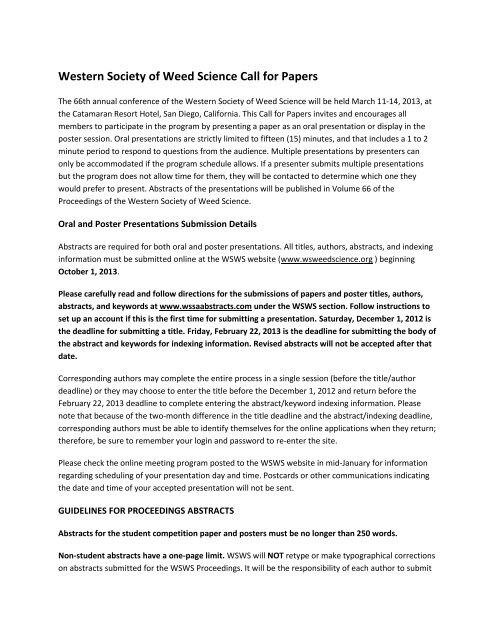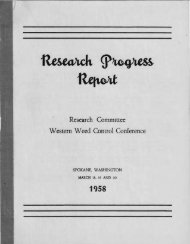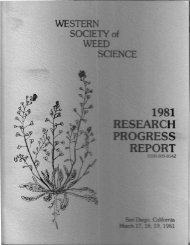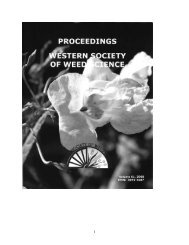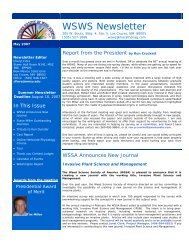Western Society of Weed Science Call for Papers
Western Society of Weed Science Call for Papers
Western Society of Weed Science Call for Papers
You also want an ePaper? Increase the reach of your titles
YUMPU automatically turns print PDFs into web optimized ePapers that Google loves.
<strong>Western</strong> <strong>Society</strong> <strong>of</strong> <strong>Weed</strong> <strong>Science</strong> <strong>Call</strong> <strong>for</strong> <strong>Papers</strong><br />
The 66th annual conference <strong>of</strong> the <strong>Western</strong> <strong>Society</strong> <strong>of</strong> <strong>Weed</strong> <strong>Science</strong> will be held March 11-14, 2013, at<br />
the Catamaran Resort Hotel, San Diego, Cali<strong>for</strong>nia. This <strong>Call</strong> <strong>for</strong> <strong>Papers</strong> invites and encourages all<br />
members to participate in the program by presenting a paper as an oral presentation or display in the<br />
poster session. Oral presentations are strictly limited to fifteen (15) minutes, and that includes a 1 to 2<br />
minute period to respond to questions from the audience. Multiple presentations by presenters can<br />
only be accommodated if the program schedule allows. If a presenter submits multiple presentations<br />
but the program does not allow time <strong>for</strong> them, they will be contacted to determine which one they<br />
would prefer to present. Abstracts <strong>of</strong> the presentations will be published in Volume 66 <strong>of</strong> the<br />
Proceedings <strong>of</strong> the <strong>Western</strong> <strong>Society</strong> <strong>of</strong> <strong>Weed</strong> <strong>Science</strong>.<br />
Oral and Poster Presentations Submission Details<br />
Abstracts are required <strong>for</strong> both oral and poster presentations. All titles, authors, abstracts, and indexing<br />
in<strong>for</strong>mation must be submitted online at the WSWS website (www.wsweedscience.org ) beginning<br />
October 1, 2013.<br />
Please carefully read and follow directions <strong>for</strong> the submissions <strong>of</strong> papers and poster titles, authors,<br />
abstracts, and keywords at www.wssaabstracts.com under the WSWS section. Follow instructions to<br />
set up an account if this is the first time <strong>for</strong> submitting a presentation. Saturday, December 1, 2012 is<br />
the deadline <strong>for</strong> submitting a title. Friday, February 22, 2013 is the deadline <strong>for</strong> submitting the body <strong>of</strong><br />
the abstract and keywords <strong>for</strong> indexing in<strong>for</strong>mation. Revised abstracts will not be accepted after that<br />
date.<br />
Corresponding authors may complete the entire process in a single session (be<strong>for</strong>e the title/author<br />
deadline) or they may choose to enter the title be<strong>for</strong>e the December 1, 2012 and return be<strong>for</strong>e the<br />
February 22, 2013 deadline to complete entering the abstract/keyword indexing in<strong>for</strong>mation. Please<br />
note that because <strong>of</strong> the two-month difference in the title deadline and the abstract/indexing deadline,<br />
corresponding authors must be able to identify themselves <strong>for</strong> the online applications when they return;<br />
there<strong>for</strong>e, be sure to remember your login and password to re-enter the site.<br />
Please check the online meeting program posted to the WSWS website in mid-January <strong>for</strong> in<strong>for</strong>mation<br />
regarding scheduling <strong>of</strong> your presentation day and time. Postcards or other communications indicating<br />
the date and time <strong>of</strong> your accepted presentation will not be sent.<br />
GUIDELINES FOR PROCEEDINGS ABSTRACTS<br />
Abstracts <strong>for</strong> the student competition paper and posters must be no longer than 250 words.<br />
Non-student abstracts have a one-page limit. WSWS will NOT retype or make typographical corrections<br />
on abstracts submitted <strong>for</strong> the WSWS Proceedings. It will be the responsibility <strong>of</strong> each author to submit
their abstract ready-<strong>for</strong>-publication following the guidelines printed below and on the website. Please<br />
refer to the WSWS Abstract Site at www.wssaabstracts.com <strong>for</strong> the most current guidelines (they may<br />
take precedent), and be sure to follow instructions on the website <strong>for</strong> online submissions. See WSWS<br />
Proceedings Volume 64 or other previous proceedings <strong>for</strong> examples <strong>of</strong> abstracts.<br />
Preparation <strong>of</strong> abstracts: Authors must complete online meeting registration prior to submitting<br />
abstract in<strong>for</strong>mation. Authors not currently members <strong>of</strong> the WSWS must complete the new member<br />
<strong>for</strong>m in order to login to the meeting registration section. Presentation in<strong>for</strong>mation <strong>for</strong> each author<br />
must be submitted online.<br />
CAREFULLY READ AND FOLLOW ALL DIRECTIONS ON THE WEBSITE.<br />
The following guidelines <strong>for</strong> content and style should be followed when preparing your abstract <strong>for</strong><br />
submission.<br />
Title: Submit your title exactly as you want it to appear in the program; the website abstract application<br />
will <strong>for</strong>mat the title properly <strong>for</strong> the abstract. Use title capitalization, i.e., capitalize the first letter only<br />
<strong>of</strong> all main words. Use only common or coded names <strong>of</strong> herbicides (not trade names) and common<br />
names <strong>of</strong> weeds and other plants.<br />
Authors: Enter all author in<strong>for</strong>mation as directed on the website. The site will <strong>for</strong>mat author in<strong>for</strong>mation<br />
<strong>for</strong> you. Authors who have previously submitted papers or posters may appear in the dropdown menu<br />
listing.<br />
Body <strong>of</strong> the Abstract: The abstract should be written as a single paragraph and contain brief<br />
descriptions <strong>of</strong> the research and the methods used as well as a descriptive summary <strong>of</strong> the results<br />
obtained. The abstract should contain meaningful in<strong>for</strong>mation on completed research. Abstracts<br />
containing statements such as “results will be presented” may result in rejection <strong>of</strong> the paper.<br />
Abstracts can be entered by using common toolbar menus on the website.<br />
ABSTRACT EXAMPLE<br />
Seedling alfalfa requires effective broad-spectrum weed control <strong>for</strong> successful establishment; however,<br />
few herbicides are registered <strong>for</strong> postemergence broadleaf weed control. Since bromoxynil was recently<br />
labeled <strong>for</strong> broadleaf weed control in seedling alfalfa, field trials were conducted at the Research and<br />
Extension Center, Torrington, Wyoming <strong>for</strong> 2 yr to evaluate weed control and alfalfa tolerance with<br />
bromoxynil, alone and in combination with other herbicides. Common lambsquarters, kochia, wild<br />
buckwheat and Russian thistle weed control was excellent (›95%) at the 0.38 lb ai/A rate. Growth<br />
chamber experiments were initiated in 1988 and 1989 to evaluate the influence <strong>of</strong> temperature on<br />
bromoxynil phytotoxicity to seedling alfalfa. Two alfalfa varieties (Apollo II and Ranger) were treated<br />
with five rates <strong>of</strong> bromoxynil (0.25 to 2 lbs ai/A) at three temperatures (50, 70, and 90 F). Alfalfa injury<br />
with bromoxynil increased as temperature increased, regardless <strong>of</strong> variety or rate. The greatest<br />
phytotoxicity occurred at 90 F, with injury ranging from 15 to 67% at the 0.25 and 2.0 lb. ai/A rates,
espectively. Alfalfa dry weight reductions (as a percentage <strong>of</strong> the untreated check) showed similar<br />
trends. (Published with the approval <strong>of</strong> the Wyoming Agricultural Experiment Station).<br />
Abbreviations: Use abbreviations as shown in the CBE Style Manual, 6th Edition, American Institute <strong>of</strong><br />
Biological <strong>Science</strong>s, Washington D. C., and as commonly used in the Journal <strong>of</strong> <strong>Weed</strong> <strong>Science</strong>.<br />
Abbreviations <strong>for</strong> weeds cannot be used. View a recent volume <strong>of</strong> the proceedings <strong>for</strong> accepted<br />
abbreviations. Do not place a period after the abbreviation unless omission would cause confusion.<br />
Abbreviations not shown in the Style manual should be introduced in parentheses immediately after the<br />
first use in the text.<br />
Numbers : Use Arabic numerals <strong>for</strong> numbers with two or more digits and <strong>for</strong> measurements <strong>of</strong> time,<br />
weight, and degrees, except when the number is the first word <strong>of</strong> a sentence. Spell out numbers less<br />
than 10 or when they are the first word <strong>of</strong> a sentence, except when they constitute a series in which one<br />
number has two or more digits. Write 10 to 20 rather than 10 x 20 and 1 to 5 rather than 1-5.<br />
Units : Either English or metric units are acceptable. However, do not mix English or metric units (some<br />
exceptions apply – e.g., soil bulk density is best expressed in metric units as g/cm3).<br />
Plant names: The Proceedings will contain a subject index there<strong>for</strong>e; authors must identify the plants in<br />
their abstract on the abstract submission <strong>for</strong>m so the proceedings index can be compiled accordingly.<br />
<strong>Weed</strong>s can be appropriately identified in the abstract by using only the WSSA-accepted common names<br />
(refer to www.wssa.net ): it is not necessary to list the Latin binomial <strong>for</strong> these plants. If a plant name is<br />
not in the Composite List <strong>of</strong> <strong>Weed</strong>s, include the Latin binomial plus authority in parentheses after the<br />
common name at the first mention.<br />
Herbicide names: The proceedings will contain a subject index that includes common and coded<br />
herbicide names with corresponding chemical names. Authors must identify the herbicides mentioned<br />
in the abstract on the on-line <strong>for</strong>m to be indexed correctly. Usually, only common names or code<br />
numbers will appear in the printed abstract, but the authors must communicate to the Editor on the<br />
abstract submission <strong>for</strong>m the identity <strong>of</strong> the herbicides. Herbicide names with WSSA-approved<br />
common names (listed in WEED SCIENCE issue No. 6 each year or at www.wssa.net), should be<br />
identified only by common name. Other herbicides must be identified by giving the code number<br />
followed by the chemical name in parentheses, if the chemical name is known. Do not use trade names<br />
in the title <strong>of</strong> the paper. Do not use abbreviations <strong>for</strong> common names or code numbers <strong>of</strong> herbicides.<br />
Herbicide rates: Express rates as ai (active ingredient) or ae (acid equivalent), whichever applies, not as<br />
<strong>for</strong>mulated material. It is appropriate to mention the specific ester or salt <strong>of</strong> an herbicide utilized in the<br />
research <strong>for</strong> clarity purposes. Express rates as a decimal; do not use fractions (0.5, not 1⁄2). Place a<br />
zero to the left <strong>of</strong> the decimal (0.5, not .5) and do not add terminal zeros (0.5, not 0.50; 1, not 1.0).<br />
Approval: If your agency or institution requires <strong>of</strong>ficial approval <strong>for</strong> this type <strong>of</strong> publication, you are<br />
responsible <strong>for</strong> obtaining such approval. Remember, to maintain the quality <strong>of</strong> the Proceedings that has
een established over the years, all authors must follow these guidelines. Submitted abstracts that do<br />
not con<strong>for</strong>m to this <strong>for</strong>mat requirement will not be published.<br />
GUIDELINES FOR THE PREPARATION OF POSTERS<br />
One 48-inch by 48-inch board and an easel will be provided <strong>for</strong> each poster presentation. There will be<br />
no exception to this rule. Authors should use their imagination and initiative in preparing components <strong>of</strong><br />
the poster <strong>for</strong> ease <strong>of</strong> transport, assembly, and presentation. Text, graphs, and tables contained on the<br />
poster should be easily read from a distance <strong>of</strong> 6 feet. Titles and headings should be large and readable<br />
from a greater distance. Because <strong>of</strong> cost and logistics, it will not be possible to provide electrical<br />
connections, telephone lines or computer connections, video equipment (VCR and video monitor), or<br />
other special equipment <strong>for</strong> posters. Use pins to attach your poster to the board, please do not use<br />
tape to. All posters must be set up on Monday evening prior to the Tuesday morning poster session,<br />
and remain on display until after the end <strong>of</strong> sessions on Wednesday afternoon. Posters must be<br />
removed from display by Wednesday evening.<br />
GUIDELINES FOR PREPARATION OF ORAL PRESENTATIONS<br />
All oral presentations <strong>for</strong> the 2013 meeting will be made by using LCD projection equipment. Neither<br />
slide projectors nor overhead projectors will be available. Please read the following instructions<br />
carefully.<br />
Format: All presentations must be in PowerPoint <strong>for</strong> MS Windows (any version). The presentation must<br />
be saved as a PowerPoint Show file (.PPS file). Limit the size <strong>of</strong> your presentation to less than 10 MB. No<br />
audio clips or sounds will be allowed and all pictures must be compressed. Video clips and animation are<br />
discouraged. In<strong>for</strong>m the project chair at the time the presentation is submitted if you need to use a<br />
video clip. Limit fonts used in presentations to basic fonts such as: Times, Arial, Courier, or Tahoma.<br />
Project chairs and computer operators are not responsible <strong>for</strong> changes in fonts, bullets, and other<br />
<strong>for</strong>matting at the time <strong>of</strong> presentation. You will be able to preview your presentation at the meeting to<br />
ensure that the <strong>for</strong>mats/fonts are all as you intended them to be. Please check the meeting program <strong>for</strong><br />
the time and place to preview your presentation. Last minute editing is strongly discouraged. Use up-todate<br />
virus protection s<strong>of</strong>tware to avoid infecting the computers provided by the project chairs.<br />
Submission <strong>of</strong> Presentations: All presentations are to be uploaded to the Title/Abstract website. Only<br />
as a last resort are they to be submitted directly to the Project Chair.


